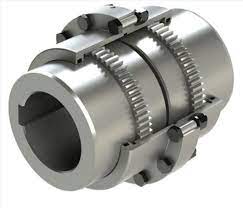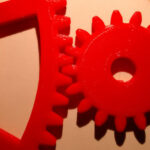Couplings are used as connecting elements between two shafts. The complexity in the type of connectivity, the power to be transmitted and the area of application tend to play a vital role in the selection of the type of the coupling.
Gear Couplings belong to the category of flexible couplings that are capable of transmitting very high torques. Constructionally the gear coupling utilizes the advantages of gear engineering; practically the coupling is a complete gear assembly. Let us now look into the constructional aspects of the coupling.

1. The gear couplings consists of a forged sleeve with internal teeth cut on its inside. The forged sleeves are normally two halves possessing internal gears in both of them. In certain cases the forged sleeve tends to remain a single piece.
2. Two hubs with external teeth containing the same number of teeth as in the internal gear is present with each one being mounted on the driven and driver shaft respectively. The tooth profile of the external teeth is normally crowned in order to take up more loads.
3. The entire assembly in normally enclosed and is provided with gaskets at the joints and O-rings at vantage points in order to prevent the leakage of the lubricant filled inside the coupling,
4. Lubrication plugs are provided at vantage points in order to lubricate the couplings during predetermined intervals of time.
Tooth forms in the Coupling:
Three types of external teeth are used in gear couplings. The only difference is the manufacturing methodology of the same.
a.) Straight Teeth: The external teeth in the hub are straight. During the condition of misalignment in the coupling the contact pattern between the internal gear and the external gear tends to be line type of contact.
b.) Crowning with constant radius: The external teeth are barrel shaped with a constant radius in order to increase the area of contact and move the area of contact to a near middle portion of the teeth.
c.) Crowning with variable radius: The external teeth are barrel shaped with a variable radius instead of constant radius. This increases the area of the contact significantly compared to that of the constant radius crowning.
The maximum degree of misalignment permissible in gear couplings is from 0.5 Degrees to 1.5 Degrees. This varies with the size of the coupling being used.
Selection procedure for gear coupling:
The gear couplings are selected based on the torque ratings.
● 1. The torque transmitted by the coupling is to be determined.
● 2. Based on the application the appropriate service factor needs to be determined.
3. The equivalent torque is to be determined by multiplying the service factor with the torque transmitted.
4. Select the coupling based on the equivalent torque value calculated. A reference selection chart is given below for example.



